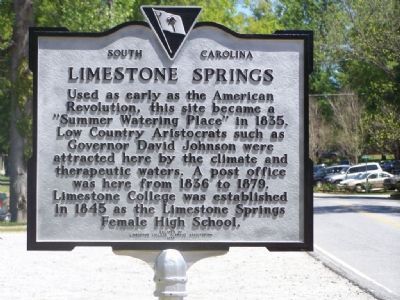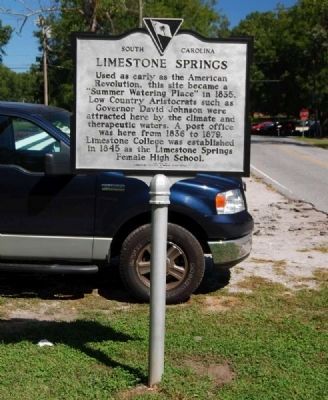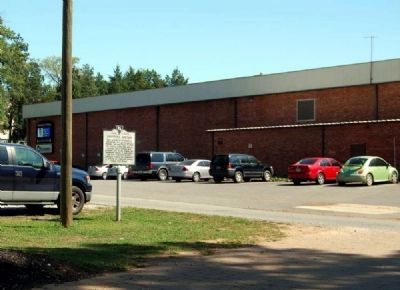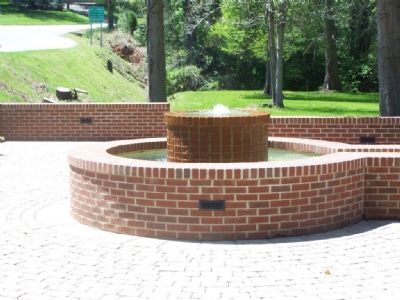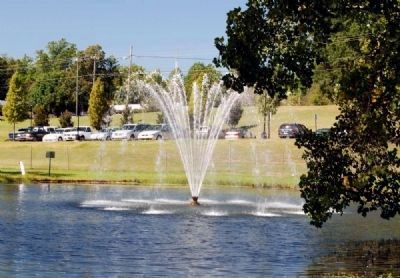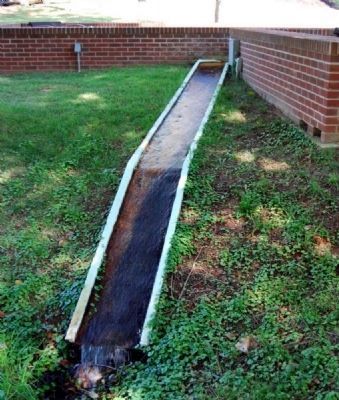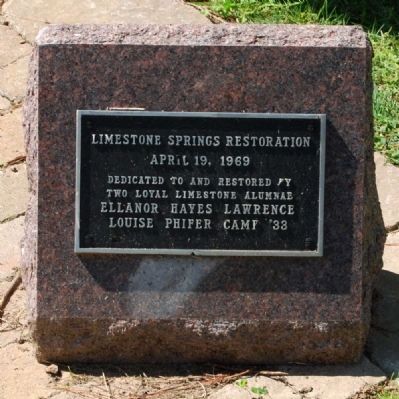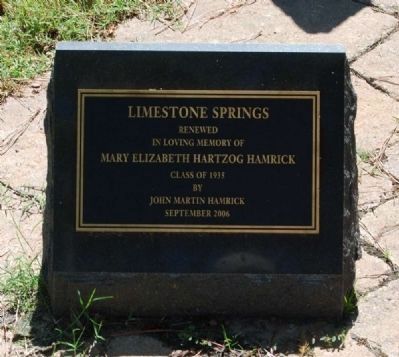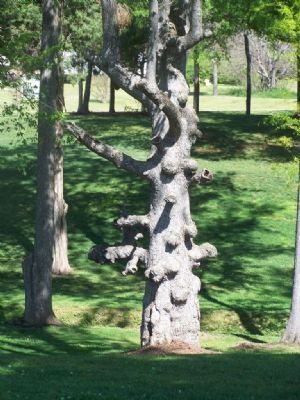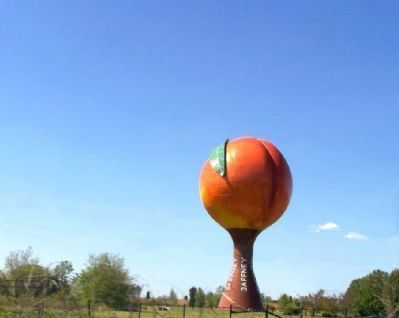Gaffney in Cherokee County, South Carolina — The American South (South Atlantic)
Limestone Springs
Used as early as the American Revolution, this site became a “Summer Watering Place” in 1835. Low country aristocrats such as Governor David Johnson were attracted here by the climate and therapeutic waters. A post office was here from 1836 to 1879. Limestone College was established in 1845 as the Limestone Springs Female High School.
Erected 1969 by Limestone College Alumnae Assoc. (Marker Number 11-1.)
Topics. This historical marker is listed in these topic lists: Colonial Era • Education • Landmarks. A significant historical year for this entry is 1835.
Location. 35° 3.317′ N, 81° 38.983′ W. Marker is in Gaffney, South Carolina, in Cherokee County. Marker is on East Oneal Street, on the right when traveling west. Touch for map. Marker is in this post office area: Gaffney SC 29340, United States of America. Touch for directions.
Other nearby markers. At least 10 other markers are within one mile of this marker, measured as the crow flies. Curtis Building (within shouting distance of this marker); Hamrick Hall of Science (within shouting distance of this marker); Carroll School of Fine Arts Building (about 400 feet away, measured in a direct line); The Reverend Thomas Curtis, D.D. (about 400 feet away); Winnie Davis Hall (about 400 feet away); Limestone College (approx. 0.2 miles away); Trail of Dog Wood Spring (approx. half a mile away); Towne Center (approx. 0.9 miles away); Granard Graded and High School / Granard High School (approx. one mile away); Dunton Chapel Methodist Church (approx. 1.1 miles away). Touch for a list and map of all markers in Gaffney.
Regarding Limestone Springs. “Limestone College of Gaffney grew out of Limestone Springs Female High School (1845). It was located on the Limestone Springs Hotel property, purchased by Rev. Thomas and William Curtis, Baptist clergymen, who operated the school from 1845 to 1863, and after the [Civil] War from 1866 to 1872. The school was reopened in 1873 under Major Bomar and Captain Petty, with Peter Cooper of New York as a generous contributor. In 1880 as Cooper-Limestone Institute for Young Ladies, the school was placed under control of the Baptists of Spartanburg County, to which religious group Peter Cooper had donated his share of the property. In 1899 the present title, Limestone College, was adopted. The name, from the hotel, is for the many limestone kilns and springs in the area. From 1921 to 1941 the college was under the Baptist State Convention of South Carolina. Now independent and coeducational, Limestone College has an enrollment of 500.
“Many of these college names are preserved as street names in the post-World War II town of Forest Acres in the eastern part of Greater Columbia. There south of Forest Drive in the residential section titled Jackson Heights are straight and winding, long and short roads named Chicora (a college in Columbia prior to combining in the 1930’s with Queen’s College in Charlotte, North Carolina), Citadel, Clemson, Coker, Converse, Erskine, Furman, Lander, Limestone, Winthrop.” — Claude Henry Neuffer
Also see . . . Limestone Springs Historic District. The Limestone Springs Historic District includes ten buildings and one site associated with Limestone College and the community of Limestone Springs. (Submitted on December 19, 2007, by Mike Stroud of Bluffton, South Carolina.)
Additional commentary.
1. Limestone Springs Historic District
The Limestone Springs Historic District includes ten buildings and one site associated with Limestone College and the community of Limestone Springs. The focal point of the district is the historic section of the Limestone College campus, which contains nine buildings constructed between ca. 1837 and 1941. The buildings on the campus are oriented towards a central lawn and fountain. Also included in the district are a Limestone quarry that was mined in the nineteenth and early twentieth century and a mid-nineteenth century church building. The limestone quarry is located adjacent to the historic section of the campus and the Limestone Springs Baptist Church is adjacent to the quarry.
1. Winnie Davis Hall: Constructed in 1903 to house the Winnie Davis Hall of History, this two-story, brick Victorian Gothic building features a crenellated central tower, projecting central bay with gable, and grouped lancet windows. Winnie Davis Hall was individually listed on the National Register in 1977.
4. Limestone Springs Hotel Building: This four-story, brick building, which was constructed ca. 1837 as a hotel, is the oldest building on the campus of the college. Several changes have been made to the building since its construction. Originally the building faced south, but around 1897 the north elevation became the main facade. The porch on the south elevation shown in an 1846 engraving has been removed as has the porch added to the north elevation around 1897. The building was originally rectangular in form, but the addition of the Curtis Administration Building and the Dixie Lodge Building now give the appearance of a "T" Plan.
5. Curtis Administration Building: Added to the Limestone Springs Hotel Building in 1899, this two-story, brick building features a rectangular central tower with decorative pediment and ribbed dare. The two-story pedimented portico with Doric columns was added in 1939.
8. Hamrick Hall of Science: This two-story, brick building was completed in 1925 as a science hall. The facade features a two-story, limestone, Doric portico with simple entablature and cornice. The main entrance has a pediment and recessed double doors. A one-story, brick addition was added to the rear in 1961.
9. Carroll School of Fine Arts Building: This two-story, brick, Neo-Classical style building was completed in 1925. The facade features a two-story, pedimented portico with Doric columns.
10. Nesbitt's Quarry: This site was the location of a limestone quarry at least by 1820. The quarry was worked through much of the nineteenth and early twentieth century. Although most of the limestone was removed by the open pit method, some underground shafts of approximately 100 to 150 feet were excavated from the walls of the quarry. Since the site was abandoned in 1953, the quarry has filled with water.
11. Limestone Springs Baptist Church, 907 O'Neal Street: This one-story, brick church was constructed in 1846 to serve the students and residents of Limestone Springs. The building features a two-tiered tower on the facade and brick quoining. The main entrance, in the tower, has double doors beneath a semicircular transam. The upper level of the tower features wooden pilasters, rounded arch vent windows, and small pediments on each elevation. The original windows of the church were replaced with modern casement windows around 1960.
Other properties contributing to the character of the district:
2. Granberry Gymnasium: Brick gymnasium building constructed in 1927.
3. Eunice Ford Hall: This brick building was constructed in 1935 as a dormitory and attached to the Limestone Springs Hotel Building with a brick connector.
7. Ebert Dormitory: This brick building was constructed in 1941 as a dormitory and attached to the Limestone Springs Hotel Building with a brick wing.
Significance
The Limestone Springs Historic District is a significant collection of properties reflecting the history of the area in the nineteenth and early twentieth centuries as a popular resort, as a center of lime production, and as a center of female education.
In the early nineteenth century the Limestone Springs were known as Nesbitt's springs. Wilson Nesbitt, the owner of the springs, was operating a limestone quarry and kiln near the springs by 1820. Nesbitt was an iron manufacturer and limestone was used in the smelting of iron ore.
In 1837 the Limestone Springs Company purchased 300 acres containing the lime kiln and springs from Nesbitt and built a four-story, brick hotel. The relatively cool climate was believed to be healthy and waters from the Limestone Springs were said to restore strength and appetite. According to an 1841 advertisement guests would find "'Baths, cold, warm, and shower, always ready at a moments notice.'" Dances held in the hotel and races at a nearby track appealed to those seeking recreation as well as health. For a time the hotel enjoyed a brisk trade, attracting many lowcountry visitors, but the company was not able to make a profit on its investment and the hotel was closed around 1844.
In 1845 Thomas Curtis, a native of England and a scholar and Baptist minister, and his son William Curtis, also a Baptist minister, purchased the Limestone Springs property. In 1845 the Curtises opened the Limestone Springs Female High School in the hotel building. The school was nonsectarian and in the most advanced department, courses included philosophy, theology, algebra, geometry and higher mathematics, chemistry, geology, astronomy, English poetry and composition, French, and Classical studies. The popularity of the school grew, and by 1859 there was an enrollment of 151, including students from North Carolina, Georgia, Florida, Louisiana, Tennessee, Alabama, and Mississippi as well as South Carolina.
In addition to administering the school, the Curtises founded the Limestone Springs Baptist Church and began a business in the quarrying, burning, and sale of limestone, which was sold to builders, contractors, and merchants.
After the death of Thomas Curtis in 1859, his son continued to operate the school. During the Civil War and Reconstruction the school experienced financial difficulties and in 1871 Curtis was forced to sell the property.
During the 1870s attempts by new owners to revive the school were only moderately successful. In 1877 the current owners, Thomas H. Banar and Charles Petty, persuaded Peter Cooper, a New York philanthropist and founder of Cooper Union, to lend financial support to the school. In return Cooper took a mortgage on the property. It was believed that the sale of lime from the quarry could result in large revenues for the school and Cooper provided loans to make improvements in the burning of lime, to build a tram railroad to carry lime to the main railway, and to purchase machinery to make barrels in which to ship the lime.
Cooper's plan of establishing a school similar to Cooper Union on the campus failed to materialize and in 1880 he donated his share of the Limestone High School property to the Spartanburg Baptist Association to be used for educational purposes and canceled the mortgage.
The association purchased the remaining interest in the property from Banar and in 1881 the school reopened as the Cooper-Limestone Institute for Young Ladies. In 1898 the name was changed to Limestone College.
In 1883 in order to pay debts the Cooper-Limestone Institute sold the property containing the quarry and kilns to W.H.H. Richardson, who expanded the lime manufacturing operations. Line production at Limestone Springs under various owners continued through the late nineteenth century. Lime shipped from Limestone Springs was sold for agricultural purposes and for building products.
Lee Davis Lodge was appointed president of Limestone College in 1899, serving until 1923. Under his direction the curriculum was broadened and academic standards raised. The Winnie Davis School of History, which promoted the study of Southern history and literature, was developed. as a result of his devotion to the South. In 1921 the control and direction of Limestone was given to the State Convention of the Baptist Denomination of South Carolina. At the time of Lodge's death in 1923, the enrollment of the college was 230.
Robert Granberry became president after the death of Lodge. During his tenure (1923-1951) the school continued to gain status academically and in 1928 was admitted into the Southern Association of Colleges.
The limestone quarry and kilns, which
had continued in operation until around the First World War, were reopened in the 1930s as a source of crushed stone. Mining continued until 1953 when the quarry was exhausted. (Source: National Register nomination form.)
— Submitted October 25, 2009, by Brian Scott of Anderson, South Carolina.
Credits. This page was last revised on November 13, 2020. It was originally submitted on December 18, 2007, by Mike Stroud of Bluffton, South Carolina. This page has been viewed 4,052 times since then and 131 times this year. Last updated on August 5, 2008, by Brian Scott of Anderson, South Carolina. Photos: 1. submitted on December 18, 2007, by Mike Stroud of Bluffton, South Carolina. 2, 3. submitted on October 25, 2009, by Brian Scott of Anderson, South Carolina. 4. submitted on December 18, 2007, by Mike Stroud of Bluffton, South Carolina. 5, 6, 7, 8, 9. submitted on October 25, 2009, by Brian Scott of Anderson, South Carolina. 10, 11, 12. submitted on December 18, 2007, by Mike Stroud of Bluffton, South Carolina. • Craig Swain was the editor who published this page.
